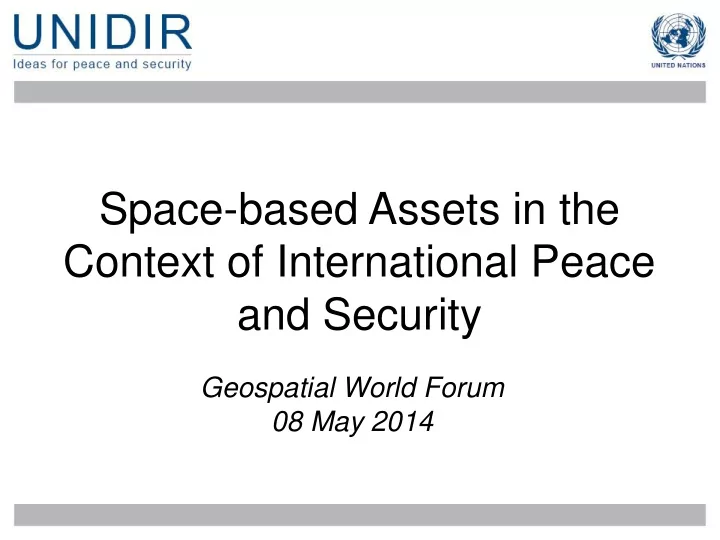

Space-based Assets in the Context of International Peace and Security Geospatial World Forum 08 May 2014
Satellites and Security Contributing to Security Since Dawn of the Space Age First use bi-lateral between former superpowers • 1960s US and Soviet first-generation early warning (infrared) satellites to detect nuclear missile launches Today known as the DSP and Cosmos series • The term National Technical Means (i.e., primarily satellites providing imaging, telemetry and missile warning) introduced into the arms control lexicon during the 1969-1972 SALT 1 negotiations between the Soviet Union and the United States
Increasingly Used in the Multilateral Arena • UNOSAT (UNITAR), created in 2000, provides satellite analysis and training to develop capacity to use sat data in humanitarian relief and human security efforts by agencies and states •UN SPIDER, created in 2006, serves as a “gateway” to satellite data (observational, meteo, GNSS) for states to use in disaster monitoring and emergency response
Private Sector Increasingly Involved • Satellite Sentinel Project – George Clooney, John Prendergast of Enough Project, and Digital Globe • Since 2010, imagery over Sudan and South Sudan publicly released to call attention to violence and humanitarian issues • Planet Labs – start-up firm, 2014, aims to provide imagery of the entire Earth updated every day • 30 Dove microsats now in orbit, 100 within the next 12 months • 3-5 megapixel images • General availability of imagery on demand by end of year
Satellites as Military Enablers Sat data increasingly important to modern militaries • Communications and GPS for navigation and targeting, • Including geospatial data for mapping, logistics management, weather monitoring • Most militaries use civil assets for mil functions (dual use) Increased fears of satellites (both military and civilian) becoming targets in crises and conflicts • Jamming/hacking/blinding • Possible kinetic energy weapons directed at satellite systems • Tested by China, Russia, US • Likely to be tested by India, Israel • Some countries reserving rights to attack space-based assets
UN GGEs on Transparency and Confidence- Building Measures (TCBMs) in Outer Space Activities GGEs are made up of experts from 15-25 UN member states; mandated by the General Assembly to study a problem and make recommendations to the GA First GGE on space TCBMs launched in 1990 • Report in 1993, largely defined the problem, need for TCBMs. Report was issued by consensus, but substance showed little agreement on how to move forward • Sat on shelves Second GGE, proposed by Russia and mandated by First Committee in 2010, GA resolution A/RES/65/68 in 2011 • Ran from 2012 to 2013
UN GGEs on TCBMs, cont’d • Report issued in July 2013 to the GA • Included recommendations on types of TCBMs, such as improved orbital data exchange • Urged the UN GA, the CD, UN COPUOS and UN member states to discuss how to move TCBM agenda forward • Final report can be found here: http://www.unidir.ch/files/medias/pdfs/final-report-29-july- 2013-eng-0-512.pdf Questions remain regarding proper forum for advancing recommendations, state “pick up” of issue, future implementation of TCBMs (devil in details)
European Proposal for an International Code of Conduct • Agreed Dec. 2008, re-released last in 2013 after consultations • General Principles • Commitment to make progress towards adherence and full implementation of current treaties and norms • Commitment to prevent space from becoming an area of conflict • Recognition that space is essential to national security and strategic stability • Development of conflict resolution processes, recognizing right of self defense
EU Proposal for an International Code, cont’d • Questions • Interaction with other initiatives • Multilateralisation of the discussion/negotiation process • Engagement of non-EU States
Draft Treaty on the Prevention of the Placement of Weapons in Outer Space or the Threat or Use of Force against Outer Space Objects (PPWT) Proposed by China and Russia, 2008, to CD under PAROS Key Provisions: • Bans weapons placed in outer space • Does not ban ground to space ASATs • Sets up an international monitoring and enforcement agency • Bans threats or use of force in space • New draft expected this year Last draft drew significant opposition from US, some others
CONCLUSION • Key Challenge to Multilateral Approaches to Space Security: • How to bring together new initiatives into a network that regulates human interaction in space, both to benefit human security and to reduce risks • Lack of a “one stop shop” to address stability/security issues is a problem • Given that outer space is globalized, it is necessary to engage all actors across stakeholder communities • Need to build capacity in developing countries • Outreach to industry continues to be inadequate
Many Thanks! Theresa Hitchens Director +41-22-917-42-93 thitchens@unog.ch
Recommend
More recommend